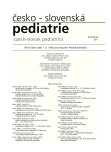The development of neonatal care and evaluation of the first five years experience in surgery of cleft lip in the neonatal period
Authors:
J. Vokurková 1,2; L. Elstnerová 3; O. Lukášová 2; I. Hufová 1
Authors‘ workplace:
Klinika popálenin a rekonstrukční chirurgie FN Brno, LF MU Brno
přednosta prof. MUDr. P. Brychta, CSc.
1; Klinika dětské chirurgie, ortopedie a traumatologie FN Brno, LF MU Brno
přednosta prof. MUDr. P. Gál, Ph. D.
2; Pediatrická klinika FN Brno, LF MU Brno
přednosta prof. MUDr. Z. Doležel, CSc.
3
Published in:
Čes-slov Pediat 2011; 66 (6): 356-362.
Category:
Original Papers
Overview
The objective of the work was to evaluate the first five years of experiences in the neonatal lip surgery of facial cleft and postoperative course of therapy at our workplace.
Methods:
The patients were treated for cleft lip, cleft lip and/or palate unilateral or bilateral since February 2005 to February 2010 at Faculty Hospital Brno. The hospital records were evaluated retrospectively.
Results:
In the cohort a total of 132 patients were enrolled. The cleft lip and palate was the most frequent (56.1%), in the unilateral forms the left-side cleft was found in 63.3%. In the first week after birth, 62.9% of newborns underwent surgery, 30.3% were operated in the second week and the remaining 6.8% underwent surgery between day 15 and 28 of life. There was no mortality and no significant anesthesia complication occurred. The postoperative artificial lung ventilation, duration of oxygen application, duration of the stay at the Intensive Care Unit, total hospitalization and other parameters observed were significantly decreasing over the years (p=0.001). The observed parameters were shorter in surgery performed in the first week of life as compared with those performed in the following weeks. Surgical complications were encountered in three cases only (2.3%).
Conclusion:
The optimal period for neonatal reconstruction of the lip and nose was found to be two days after birth. The prerequisite of successful intervention is a highly specialized workplace with experience team and top technical equipment. The early neonatal surgery of the lip exerts positive influence of the somatic development of the child, positive psychosocial effect on the family and by way of feedback on the child.
Key words:
neonatal lip surgery, cleft lip, total cleft lip palate, newborn
Sources
1. Lewin ML. Management of cleft lip and palate in the United States and Canada. Plast Reconstr Surg 1964; 33 : 383–394.
2. Desai SN. Cleft lip repair in newborn babies. Ann R Coll Surg Engl 1990; 72 : 101–103.
3. Mcheik J, Levard G, Vergnes P, et al. Early repair for infants with cleft lip. Retrospective study of 263 cleft lip repairs. Ann Chir Plast Esthet 2002; 47 : 204–209.
4. Freedlander E, Webster MH, Lewis RB, et al. Neonatal cleft lip repair in Ayrshire: a contribution to the debate. Br J Plast Surg 1990; 43 : 197–202.
5. Mcheik JN, Sfalli P, Bondonny JM, et al. Early repair for infants with cleft lip and nose. Int J Pediatr Otorhinolaryngol 2006; 70 : 1785–1790.
6. Mcheik J, Levard G. Neonatal cleft lip repair: psychological impact on mothers. Arch Pediatr 2006; 13 : 346–351.
7. Slade P, Emerson D, Freedlander E. A longitudinal comparison of the psychological impact on mothers of neonatal and 3 month repair of cleft lip. Br J Plast Surg 1999; 52 : 1–5.
8. Parameters for Evaluation and Treatment of Patients with Cleft Lip/Palate or Other Craniofacial Anomalies. American Cleft Palate-Craniofacial Association. 1993, rev. 2009. In: http://www.acpa-cpf.org/teamcare/.
9. Clarren SK, Anderson B,Wolf LS. Feeding infants born with cleft lip, cleft palate, or cleft lip and palate. Cleft Palate J 1987; 24 : 244–249.
10. Weatherley-White RC, Kuehn D, Mirrett P, et al. Early repair and breast-feeding for infants with cleft lip. Plast Reconstr Surg 1987; 79 : 879–887.
11. Harris PA, Oliver NK, Slater P, et al. Safety of neonatal cleft lip repair. J Plast Surg Hand Surg 2010; 44 : 231–236.
12. Galinier P, Salazard B, Deberail A, et al. Neonatal repair of cleft lip: a decision-making protokol. J Pediatr Surg 2008; 43 : 662–667.
13. Boon L, Manicourt D, Marbaix E, et al. A comparative analysis of healing of surgical cleft lip corrected in utero and neonates. Plast Reconstr Surg 1992; 89 : 11–20.
14. Valentová-Strenáciková S., Malina R, Selecká P, et al. Changes in alveolar cleft width in children below one year of age with complete unilateral cleft palate and lip. Rozhl Chir 2011; 90 : 250–253.
15. Mcheik JN, Levard G. Growth in infants in the first two years of life after neonatal repair for unilateral cleft lip and palate. Int J Pediatr Otorhinolaryngol 2010; 74 : 465–468.
16. Dvořák Z, Veselý J, Konvičková E, et al. Standardy multidisciplinární péče o dítě s rozštěpem obličeje. Čes-slov Pediat 2009; 64 : 236–241.
17. Borský J, Tvrdek M, Kozák J, et al. Our first experience with primary lip repair in newborns with cleft lip and palate. Acta Chir Plast 2007; 49 : 83–87.
Labels
Neonatology Paediatrics General practitioner for children and adolescentsArticle was published in
Czech-Slovak Pediatrics

2011 Issue 6
- What Effect Can Be Expected from Limosilactobacillus reuteri in Mucositis and Peri-Implantitis?
- The Importance of Limosilactobacillus reuteri in Administration to Diabetics with Gingivitis
Most read in this issue
- Necrotizing enterocolitis in full-term neonates. Case report and review of the literature
- Off-label prescribing in pediatrics
- Changes in electrical conductivity of the skin due to painful stimuli in newborns of different gestational categories and comparison with changes in selected physiological parameters
- The development of neonatal care and evaluation of the first five years experience in surgery of cleft lip in the neonatal period
